
Greetings! I’d here to report on my lovely trip to the 2019 Meeting/Conference/Symposium of the American Musical Instrument Society. As always, click on (most) photos to expand for details.
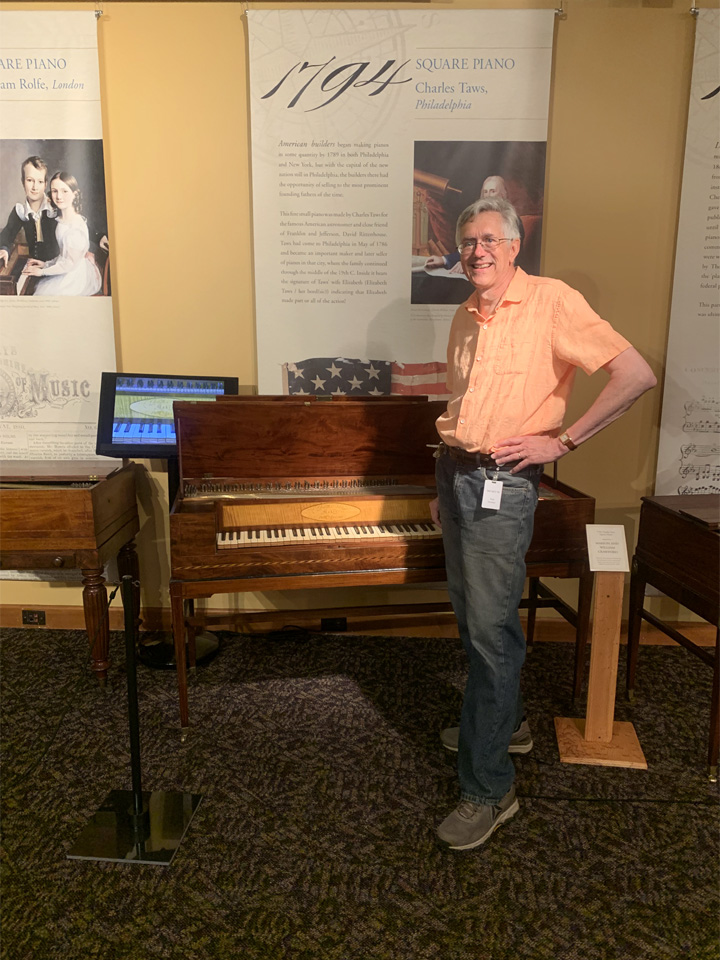
This year’s was held in Greenville, South Carolina, hosted by Tom Strange (pictured) and staff at their wonderful 1-year-old Carolina Music Museum. The impressive collection consists primarily of Tom’s historical keyboards and other donations. Displayed in a very nice brick building (originally Coca-Cola), it has been upgraded to state of the art for housing the growing collection.

Lots of gorgeous instruments on the main floor, including a 1863 London Erard Grand Piano.

I loved all the working cutaway models of various type of keyboard actions throughout history. On some, I had to shoot them in standard, then slo-mo to catch what happened!

Certainly, the museum’s prize is a stunning Jacob Kirkman double manual marquetry harpsicord from 1758 (London).

The upper floor was lined with square pianos of every description. Here, a particularly beautiful 1839 Nunns built in New York. P.S: I picked up their beautiful book Facing South: Keyboard Instruments in the Early Carolinas so as to recall, learn and peruse at my leisure.
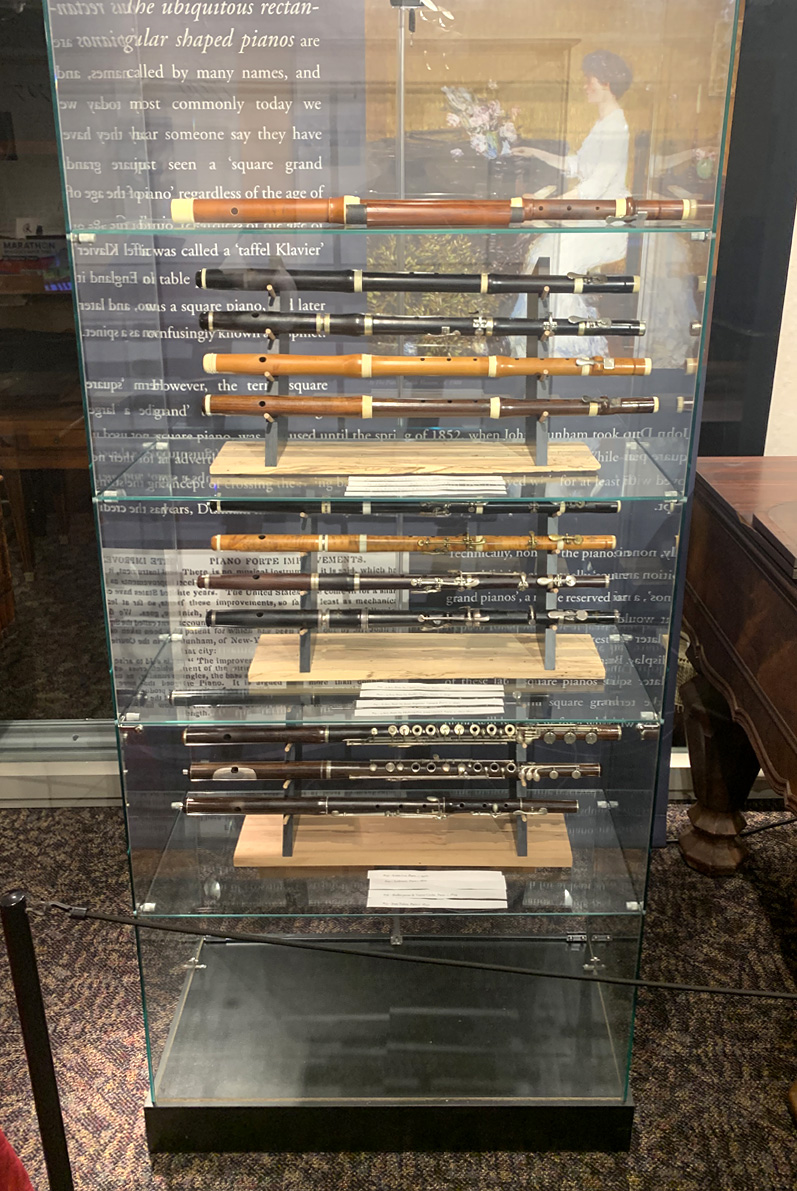
A temporary antique flute exhibit was installed for the week, thanks to AMIS member Michael Lynn – collector, performer and professor at Oberlin Conservatory.
And here I should begin my tale, as Michael was the first person I met…at the Greenville airport sometime after midnight on the 14th of May. My original flight from Chicago (to see the family) was canceled, and I just made it the same day (I couldn’t be late – I’m now on the Board of Governors and we had a rare full-time Strategic Planning Session booked for the next day). I was feeling guilty about asking for a ride that late – until I ran into Michael (we had never met but recognized each other), with the two of us next waiting for two more (from Italy) yet! We were picked up by the indefatigable Dr. Janet Page, fellow board member and much-to-her-eventual-surprise enslaved AMIS Uber chauffer for the week.

At AMIS, you’ll meet someone crushed beside you on the ride from the airport to the dorms like Patricia Garcia Gil, then find her giving a virtuoso performance on historical keyboards the next evening. That’s just how we roll.
Yes, I went the budget route this trip – no car, and dorm accommodations. Michael and I grabbed keys for a 4-plex unit; I would enjoy his company and our conversations for much of the trip. Our third roommate we met the next morning strolling around in his pajamas. This was a young professional Fulbright scholar (in from his stint in Austria) named Robert Apple. Professional, talented, scholarly and immaculately dressed at all times, I will always remember him as a Star Trek-loving nerd, as we traded witticisms and favorite Netflix series (and of course, in his pjs). You’ll see him below. Our 4th roommate we would see later and not often – Yuanchang Yang, whose quiet politeness we took as being English-deficient, until he gave his paper on the 7-string Chinese zither Qin (pronounced “chin”) in better grammar than I’ve ever managed.
As I mentioned, the first day (Wednesday) was a full Board day (I survived), then meeting old and new friends at the reception, followed by Patricia’s concert.
For the majority of the rest of the week, it was papers, papers, papers (scholarly presentations). For perhaps the first time ever, I actually sat through nearly every single one – in all fields – and A) stayed awake, B) enjoyed myself, and C) learned something. Seriously, the word on the street (and my own conclusion) was that his year’s papers were uniformly excellent.

Brass instrument research started things off – including one (by Robert Pyle) on the “Echo Cornet” – something I have seen, but never realized what it was. Pictured (courtesy Michael Lynn) are a couple examples we’d see later in the day. The bell-like chamber (imagine a kid shoving a cherry bomb into a cornet) is accessed by a 4th valve that instantly gives a quiet “reverb chamber” effect for duplicated loud/soft musical passages. The popular invention didn’t survive, but is indeed cool!

The next session was highly illuminating, presented by three Gribbon Scholars (young students awarded travel-assistance who are both more educated and mature than I). Saskia Keller (who looks just like Wallis Currie-Wood, the daughter on T.V.’s Madam Secretary, and I told her so), who won this year’s award for best Gribbon paper, told us about “side saddle” women cellists. Yes, it kinda came about for the reasons you’re thinking, but it did lead to the standardization of the end pin for all genders.
Being heretofore largely clueless about brass, I didn’t know the story of the Utleys. Once upon a time, Joe Utley built a major collection, then built a new home out in the woods somewhere out in the middle of nowhere to house it. I was told he passed away 2 decades ago, but his gracious wife Joella continues to share his passion and invited us to visit (it has all been bequeathed to the National Music Museum and will eventually end up there). The bus ride out was its own adventure, as I happened to sit with Dick Boak (of Martin Guitars fame) who shared stories and gossip of the guitar world the entire time. Seriously, a cross-country trip with this living legend wouldn’t have been boring.

After the long driveway walk, we were greeted by herald trumpeter Nikolai Manttari.
As a huge fan of, and no stranger to, unusual homes with eccentric décor (have you been to my house?), I was in my element.

Yes, that is an adult (taxidermy) cougar perched like a tabby spying on the proceedings (or dinner) below. Every surface is lined with wall-to-wall shelving. Mrs. Utley told me that all the cases were single units – when the collection moves out, they can be pulled away, leaving bare walls to hang whatever she wants. Clever! There are several dozen instruments out on loan to various museums (including the Carolina), but apparently, some 550 remained.
During the visit, Rob Apple demonstrated some of the antique brass in the collection (ergo his curator’s gloves). He had been there days earlier to prepare.

Speaking of which, Sabine Klaus (pictured) of the National Music Museum has been visiting on and off for twenty years – working on a long-term project to catalog the collection. Three incredible volumes in her book series Trumpets and Other High Brass have been published so far (two more to go, I hear!).

She had a table of rare and special items set out for us.

Beautiful and imaginative animal horn (Tibet) and cloisonne (China) Rkang-gling.
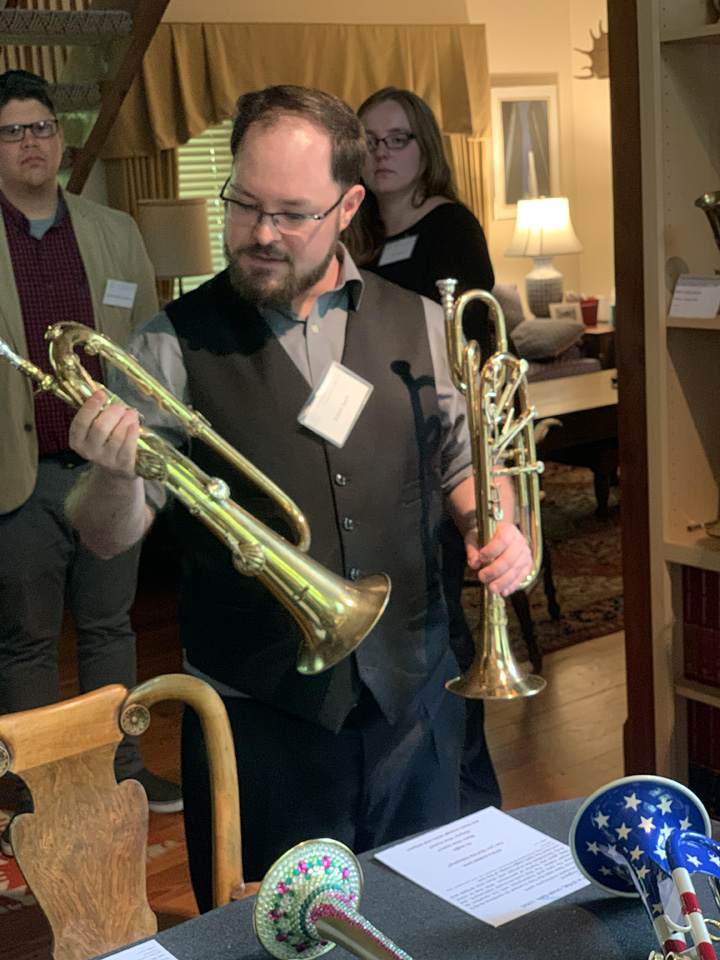
Rob Apple demonstrates and explains the difference between a keyed bugle (left) and a keyed trumpet (right). Neither the bugle and trumpet I’m familiar with have keys, so I was of course perplexed (while the engineer in me was fascinated).

I prowled around upstairs, finding strange brass instruments of every description…I’m gonna have to buy those books!

In the evening, we had a second keyboard concert by Stephanie Schmidt on various square pianos in the upper gallery. She gave us a delightful cornucopia of different styles of music, folk to Baroque, that would have been played on these instruments in America a hundred to two hundred years ago.

A highlight the next morning was the story of the making of the NY Met Museum’s Bradley Strauchen-Scherer (playing conch) incredible new “Fanfare” exhibit (photo from the Met’s web site). Try to imagine how complicated this would have been to design and construct in 3 dimensions, then multiply that by ten. I want them to do my room next.
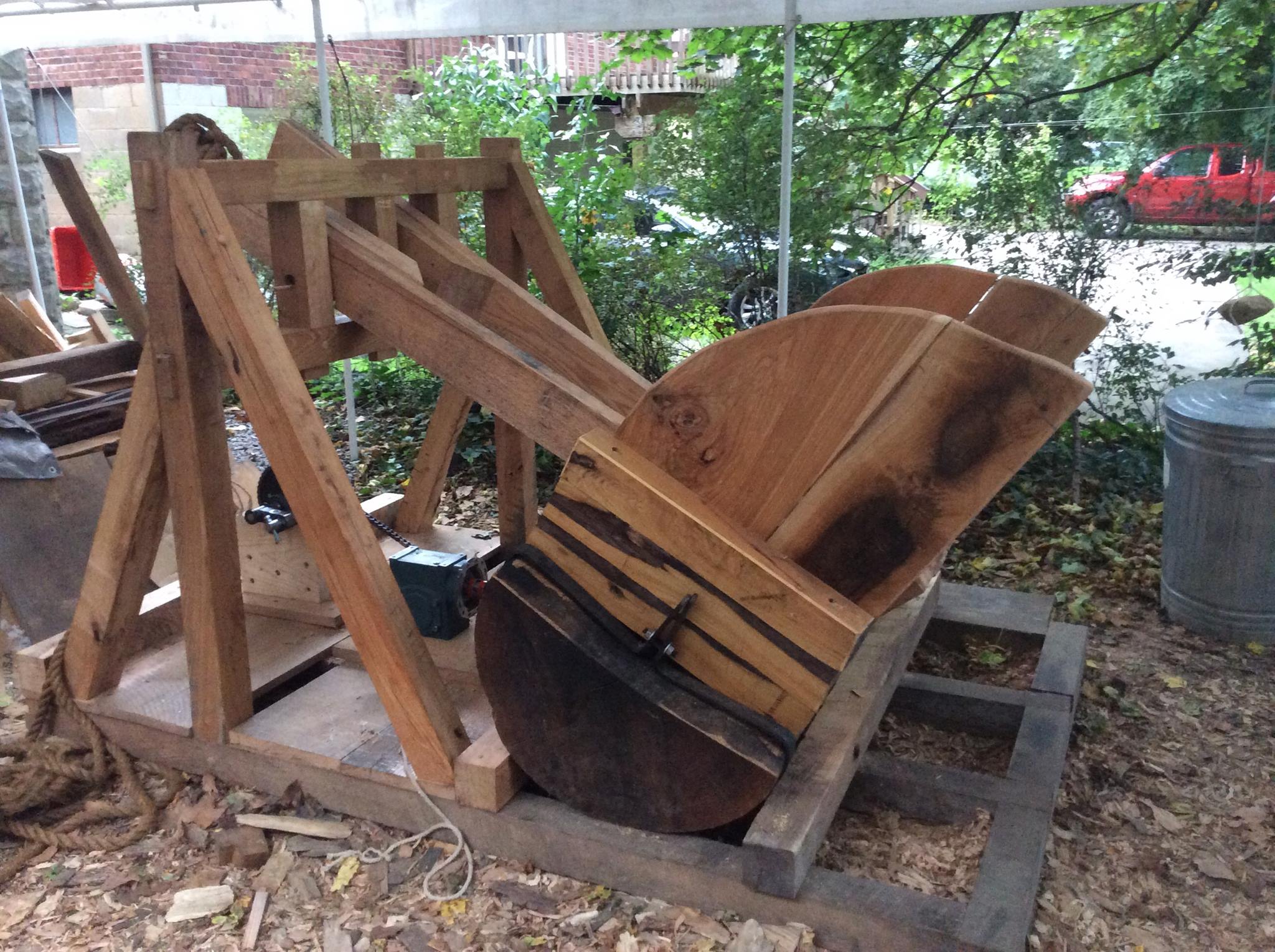
Newcomer Jason Leininger blew our minds with his dedication to the traditional methods of creating leather for historic pianos. He said he spent 2 years alone building this authentic “fuller mill” which pounds deerskin pieces with giant hammers (photo from his FB page). He clearly knows his stuff, having grown up with traditional “brain tanning” (yes, it’s pretty much what you’re trying hard not to think of…).

Next up, someone some of my luthier friends should know. Being on the AMIS Membership Committee, it’s pathetic that I haven’t managed to get hardly any of my plucked stringed colleagues to join or attend (apparently, I either I suck at my job, or I have no friends). My pal Daniel Wheeldon, however, brought in three new friends this year – including Minnesota luthier Brian Applegate (photo by Michael Lynn), who, with a family and waiting list for his beautiful high-end guitars, decided to go back to school – going for his PhD in Edinburgh, on the subject of new sustainable replacement woods for guitars. A great addition, I hope he comes back!

During lunch, we were treated by the local Western Carolina gamelan ensemble, led by our own Will Peebles. This is not an easy “kit” to haul around and set up, and we really appreciated the effort.

This was the third time at an AMIS conference that I’ve heard one of these groups. It never fails to enchant.

Their notation system. Many of us stayed after to try our hand.

The biggest surprise among the afternoon session papers was discovering the world of Burmese Slide Guitar. I’ve been listening to Indian slide guitar for some time (specifically Vishwa Mohan Bhatt and Debashish Bhattacharya), but this was a whole new world to me. As I understand it (from musician and ethnomusicology professor Andre J. P. Elias – raised in California, now living in Hong Kong), this tradition came about even earlier (he showed us a c.1930 78 record by one of these guys!), from similar influence of the Hawaiian guitar. They then started producing their own instruments (as in this image from the Internet).


In other plucked string news, Dick Boak’s fascinating book about Richard Konter & the Byrd Polar Expeditions (A Stowaway Ukulele Revealed) is out. He talked about that and how they were able to decipher the instrument’s 150+ signatures with multispectral imaging. His co-authored book (which I picked up, naturally) tells the full story and includes a photo and bio of each of the confirmed signers (a fascinating “who’s who” list!). His display also included one of the new reproductions of the historic instrument available from the Martin Co. that Dick helped make possible. Photos courtesy Dick Boak.
A glutton for punishment, I duly went back after dinner & drinks for more evening papers (nerd scholars never sleep).
Our final Saturday was a busy one. Concurrent papers were scheduled in the morning – I went back and forth to first catch Bill Hetrick hilariously talk about “Tone-Altering Devices in American Pianos” (no, a “mandolin attachment” does not make you an honorary member of our BMG study group!). Then downstairs to see young musician Aaron Wolfe present on something near and dear to my heart – Irish bands who incorporated the (Greek, then Irish) bouzouki (Planxty, Bothy Band, etc.). Even though this was music from my, rather than his era, there were a few not on my radar. Nor did I know the full story of how the Irish bouzouki (or cittern, depending…it’s complicated) came to be.

Aaron demonstrated the instrument and style on his GDAD instrument, accompanying historical musicologist/flautist Lidia Chang.

They were jamming during lunch (Aaron is a great low whistle player) and I was invited to join in on bouzouki (one of the few plucked strings I’ve never owned or played). Great fun, though I was confused by tuning that was both 5ths and 4ths (simple but new chord shapes). Photo by (I think) Elizabeth Fleming. And forgetting music for a moment – later that night over beers, Aaron totally blew my mind with his skill on the Rubik’s Cube!
The afternoon saw a plucked string session. Daniel Wheeldon unveiled part of his ongoing PhD – a reproduced 1810 Mittenwald tastengitarre (keyed guitar). A highlight of the trip, this was an amazing thing to see.
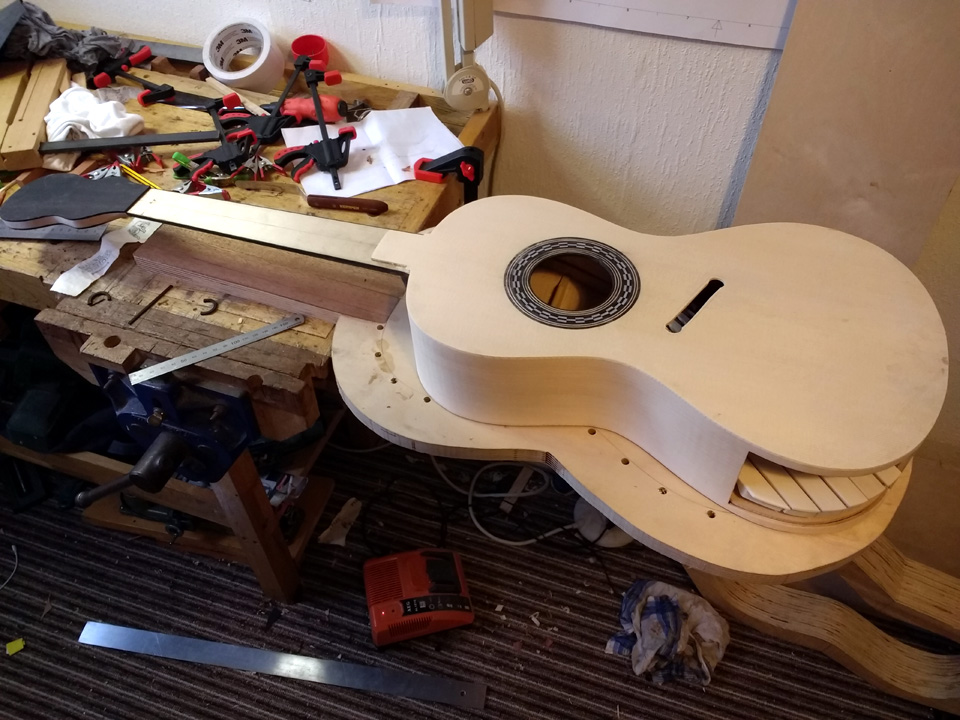
Barely one month before, he had sent me this photo, as I thought “you poor young man, there’s no way you’ll finish this in time…”! But he did – calibrating the striking mechanism and stringing it up the night before leaving.

An exceedingly rare instrument, he copied the only known gut-strung example (from an anonymous collector). He demonstrated it beautifully, suggesting that it was a simple accompaniment instrument (it did arpeggios really well). Though quiet, with a bit of keyboard clack, it was very musical and much louder and functional than I would have ever imagined (steel strings, maybe, but how can it work with gut strings?! I don’t know, but it does). I found it great fun, and one could go back and forth between plucking and striking quite easily.

He passed around his printed prototype of the mechanism.
You can see and hear the remarkable instrument in this video taken by Dick Boak, where Daniel repeats some of his presentation. Daniel also posted a full photo series of the production process on his FB page.
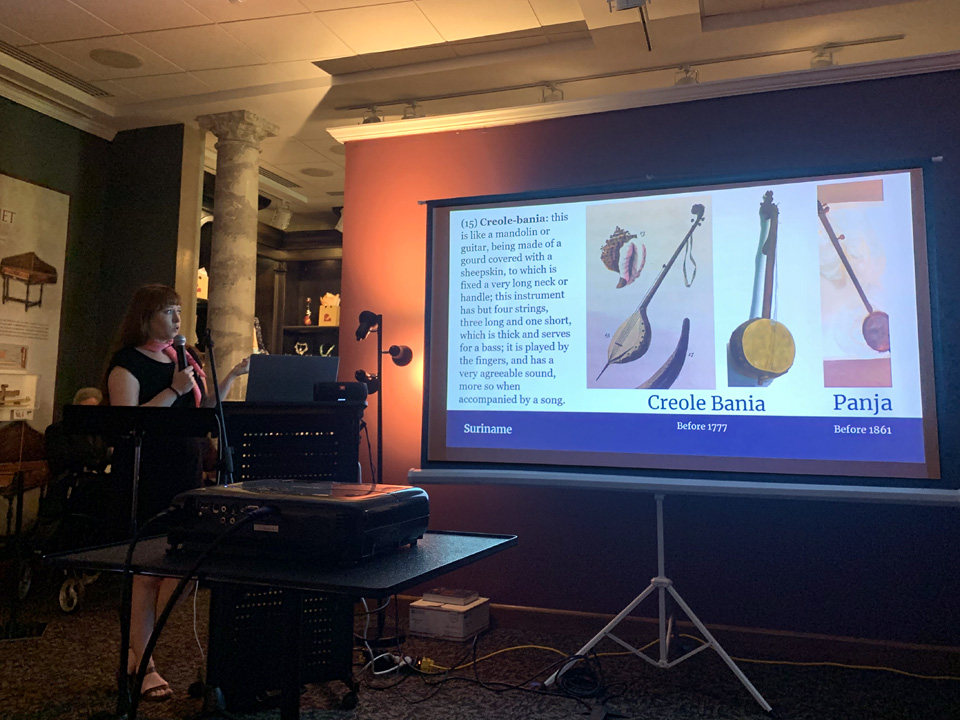
Daniel had also urged some other new friends from the Banjo Gathering to come present at AMIS. Above, Kristina Gaddy explains new discoveries and thoughts on the banjo’s true origins. It was perfect timing – I had been trying to wrap my head around all this incredible new research by various authors presented in the wonderful new book Banjo Roots and Branches (one of its chapter writers – builder Pete Ross – came with Kristina).

I followed that (photo by Michael Lynn) with my organology on archguitars (the Peter Blanchette version and beyond). Though incorporating most of my web site article, this was – like Aaron’s paper on the Irish bouzouki earlier in the day – meant to highlight the benefit (need?) of doing organology on players’ and builders’ continual new creations in “real time,” rather than waiting for someone to try 200 years from now (as I’ve struggled with harp guitars and many other obscure plucked strings).
A couple of interesting semantics issues came about before and afterward I think are worth sharing with my guitar-centric readership (or perhaps my non-guitar readership, as some of the terminology of the former may be strange to the latter). For example, 99% of us in the guitar world use the word “tone” in referring to the sound characteristics of our instruments. For the rest of the music world, it is “timbre” (pronounced TAM-ber). Thus, I use the former word in nearly all my articles, while (all?) other instrument disciplines prefer the latter. Just FYI. Similarly, most of us in guitar circles no longer differentiate between “gut” and “nylon” in discussing stringing on new or old instruments. We know and discuss the detailed differences as necessary, but use shorthand amongst ourselves – a “nylon-string guitar” is understood to use soft strings of gut, nylon, Nylgut, or various other composites – for whatever tonal goal one is after (or “timbre”…hmmm, no, still not loving it). Or, in a different setting, we’d refer to our historical instrument as “gut-strung” – even if we decide to string it with modern nylon.
Similarly, with ukes, harps, lutes and many others I imagine. I have harps strung with steel-wound basses, gut for a few octaves, then nylon. I don’t care if we call it a nylon- or gut-string instrument…the point is, it’s not a wire-strung harp. I bring this up only because my casual use totally freaked out the wind, brass and keyboard folks – they couldn’t believe I was not differentiating between nylon and gut – two completely different things! Just different perspectives – I’m always learning something new at AMIS.
Another interesting criticism came after my talk, regarding its focus on terminology and semantics in organology. The fellow (he knows who he is!) however saw my point that, like “harp guitar” and “fretless zither” and many other terms I’ve defined or explained over the years, I’ve experienced a hundred times over the need for this detailed, nerdy attention to definitions and terms in order to inform a confused (layperson) public.
Anyway, I survived.
During the week, we enjoyed the weather (which became pretty darn humid by week’s end), hospitality and sights of Greenville.

The city holds a different street festival every weekend. We were there for the Greek Fest (adjacent to their church).

I strolled over there with friends for lunch two of the days. Lots of food and entertainment.

An anonymous bandmember with a very cool cut-out solidbody electric bouzouki.
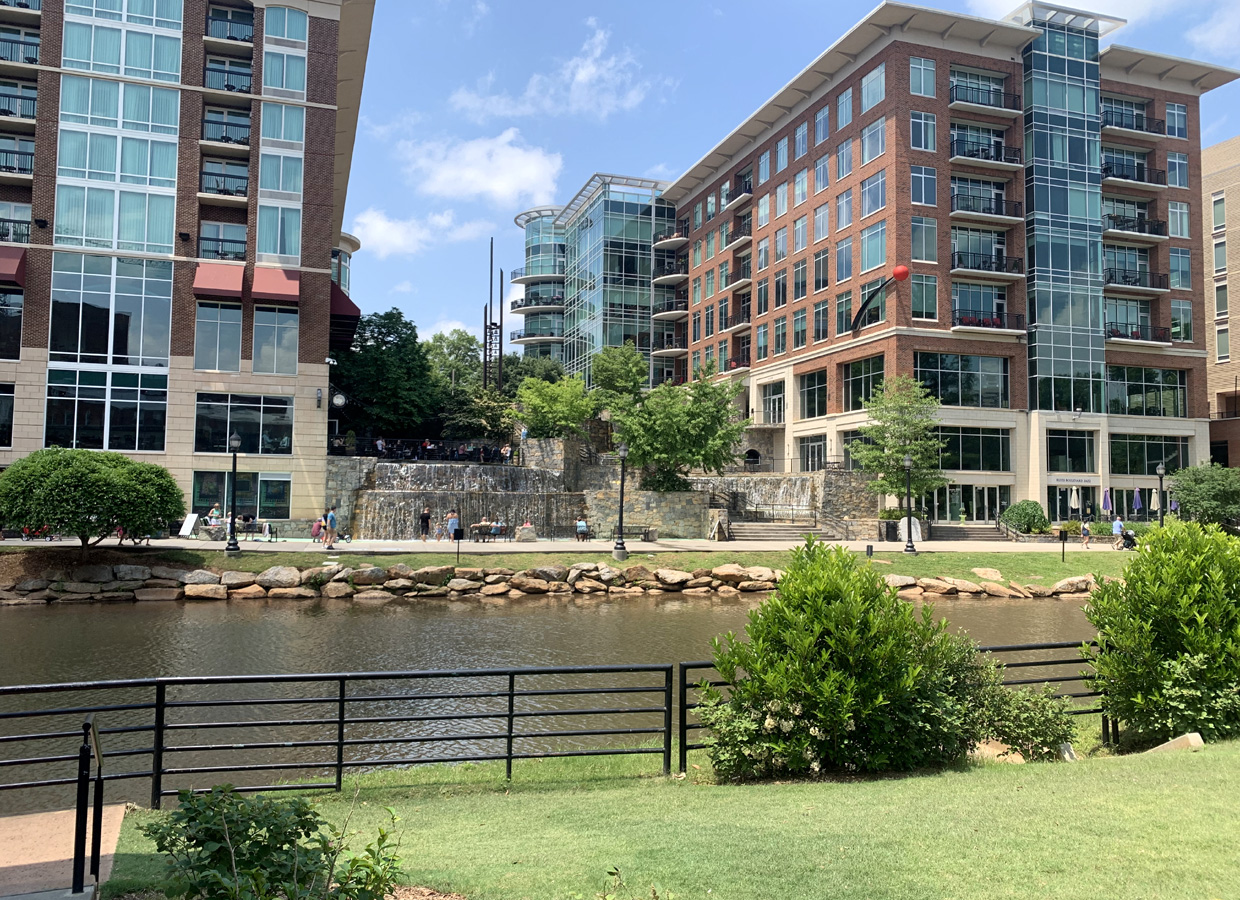
The beautiful river walk at the end of Main St. We learned that the entire downtown area was virtually rebuilt from the ground up 10 years ago – as Greenville aims to be a major weekend getaway draw.


We all loved the fantastic full-size bronze boar (or as we called it, the “drooling pig”) – an unusual choice for a decorative public fountain.
Sorry I don’t have room or time to include all the other presenters and papers (recreating George Washington’s harpsichord – including its original maker’s flaw – from scratch for Mount Vernon? Check!) and many other new friends and colleagues.
A big thanks to all Carolina Music Museum and AMIS volunteers who made this event possible.
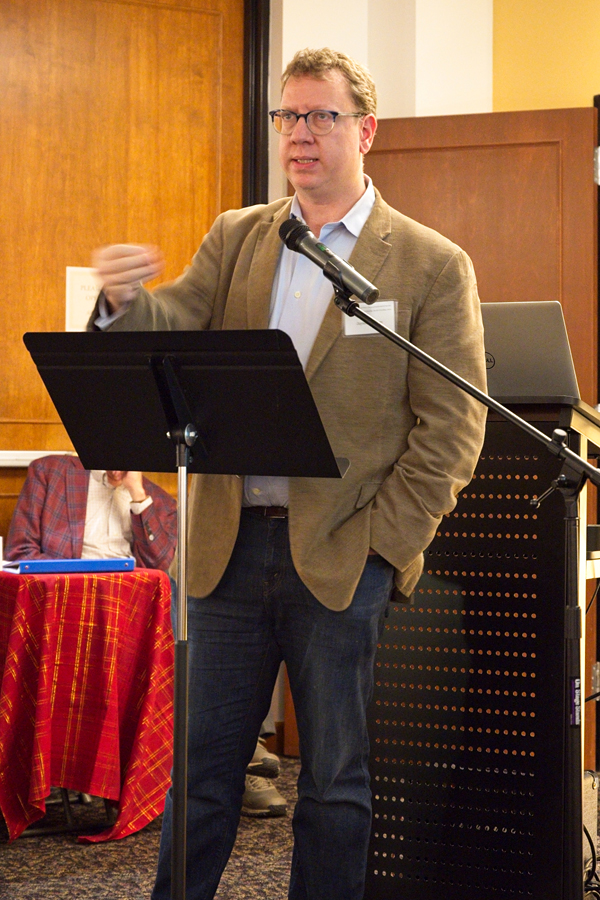
And lest I forget, a big shout out to my friend and new AMIS President Jayson Dobney (Photo by Michael Lynn). Check out his incredible “Play It Loud: Instruments of Rock and Roll” exhibit at the Met!
See you (I hope?) next June in Calgary, Canada.






Great write-up, Gregg. Love it. Now I don’t need to write one for my out-of-state family members. I’ll direct them to your blog!
Thanks, Connie – that’s what it’s there for!